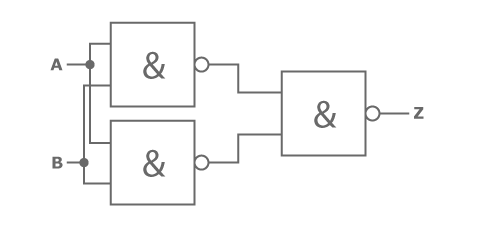The OR gate has two OR-combined input terminals.
If at least one of the input terminals is true, the output will also be true.
This means that the output Z will be HIGH (1), if input-terminal A or input-terminal B is HIGH (1). The output Z will also be HIGH (1), if both input-terminals are HIGH (1). Otherwise the output Z will be LOW (0).
claim: Emilia works as a babysitter or at the till.
(If Emilia doesn't work, the claim will be false.)
| If... | the claim will be... |
|---|---|
| Emilia doesn't work, | False |
| Emilia works as a babysitter, | True |
| Emilia works at the till, | True |
| Emilia works both as a babysitter and at the till, | True |
claim (Z) = Emilia works as a babysitter (A) or at the till (B).
| A | B | Z |
|---|---|---|
| No babysitter | No till girl | False |
| No babysitter | Till girl | True |
| Babysitter | No till girl | True |
| Babysitter | Till girl | True |
Z = A OR B
| A | B | Z |
|---|---|---|
| 0 | 0 | 0 |
| 0 | 1 | 1 |
| 1 | 0 | 1 |
| 1 | 1 | 1 |


claim: Tomorrow it will snow or it'll be warmer than 30 degrees.
If it won't snow tomorrow although it will be -2°C cold, the claim will be __________.
false
If it will be 36°C warm tomorrow, the claim will be __________.
true
If it will snow tomorrow and temperature will be 32°C, the claim will be __________.
true
It is possible to build this gate just from NAND gates:
A OR B = (A NAND A) NAND (B NAND B)
